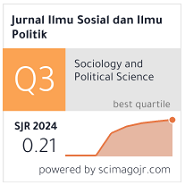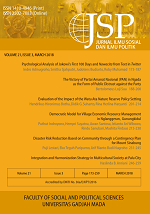Shifting the Blame: Storm and Wildfire Dramatic Images in American News Media
Aris Munandar(1*), Amin Basuki(2)
(1) Department of Intercultural Studies, Faculty of Cultural Sciences, Universitas Gadjah Mada, Indonesia
(2) Faculty of Cultural Sciences, Universitas Gadjah Mada, Indonesia
(*) Corresponding Author
Abstract
Some media frames might be likely to seek to evoke a certain sentiment, and that natural disaster coverage by the media focuses on the current impact of disasters. In their coverage, American news media use polar sentiment words to create bleeding images of natural disasters, potentially counter-productive to the wisdom of dealing with the natural disaster. Identifying the sentiment words that lead to a misperception of natural disasters can help journalists adopt the wisdom that natural disasters are not a human enemy. The corpus-assisted discourse studies (CADS) reported in this article investigates the American media's issues for dramatic reporting and the polar sentiment words utilized in the framing. The corpus is built from 100 news articles reporting wildfires and storms by ten major online American news media published from January 1, 2018, through December 31, 2020. It uses AntConc to generate word-list and word-link from which it identifies the dominant issues. Subsequently, it compares the AntConc word-list with A List of Sentiment Words to reveal the tones and dramatic imaging. The findings show that the dominant issues in storm reporting are description, impact, and prediction, while wildfire reporting are cause, impact, action, and prediction. The negative polar words produce dramatic images of storm as a violent beast and wildfire as a vengeful invader. Such description is provocative to blaming natural disasters as a cause of human suffering rather than improving our behaviors to reduce the suffering. Thus, it is counter-productive to acquiring wisdom for dealing with natural disasters.
Keywords
Full Text:
PDFReferences
Anthony, L. (2019). Antconc 3.5.8. Laurence Anthony. https://www.laurenceanthony. net/software/antconc/
Albrecht, F. (2021). Natural hazards as political events: Framing and politicisation of floods in the United Kingdom. Environmental Hazards, 1-19. https://doi.org/10.1080/17477891.2021.1898926
Arnold, M. D. (1975). Floods as Manmade Disasters. Environmental Conservation, 2(4), 257–263. https://doi.org/10.1017/S0376892900001727
Cissel, M. (2012). Media Framing. The Elon Journal of Undergraduate Research in Communications, 67–77. https://doi.org/10.4135/9781483391144.n215
Cockburn, P. (2011). Catastrophe on camera: Why media coverage of natural disasters is flawed. Independent. https://www. independent.co.uk/news/media/tv-radio/catastrophe-on-camera-why-media-coverage-of-natural-disasters-is- flawed-2189032.html
de Brito, R.P., de Souza Miguel, P.L ., & Pereirab, S.C.F. (2020). Climate risk perception and media framing. RAUSP Management Journal, 55(2), 247-262. https:// doi.org/10.1108/rausp-09-2018-0082
Earth Journalism Network. (n.d.). Reporting on Disasters | Earth Journalism Network. Earth Journalism Network. Retrieved October 19, 2021, from https://earthjournalism.net/resources/reporting-on-disasters
Grant, S., Tamason, C.C., & Jensen, P.K.M. (2015).Climatization : A critical perspective of framing disasters as climate change events. Climate Risk Management, 10, 27-34. https://doi.org/10.1016/j.crm.2015.09.003
Hoon, L.L, Shen, N.K., & Mei, T.C. (2015). News Frame of Typhoon Haiyan Disaster Coverage: A Comparative Study of Philippines Inquirer and The Wall Street Journal News Sites. The Asian Conference on Media & Mass Communication 2015 Official Conference Proceedings. http://papers. iafor.org/wp-content/uploads/papers/ mediasia2015/MediAsia2015_12043.pdf
Horsley, J. S. (2016). Media Framing Of Disasters: Implications For Disaster Response Communicators. In A. Schwarz, M. W. Seeger, & C. Auer (Eds.), The Handbook Of International Crisis Communication Research (pp. 155–164). John Wiley & Sons, Inc. https://doi.org/10.1002/9781118516812. Ch15
Houston, J. B., Pfefferbaum, B., & Rosenholtz, C. E. (2012). Disaster News: Framing and Frame Changing in Coverage of Major U.S. Natural Disasters, 2000–2010. Journalism & Mass Communication Quarterly, 89(4), 606–623. https://doi.org/ https://doi.org/10.1177/1077699012456022
Hu, M., & Liu, B. (2004). Proceeding of the ACM- SIGKDD International Conference on Knowledge Discovery and Data Mining (KDD-2004). Mining and Summarizing Customer Reviews.
Illner, P., & Holm, I. W. (2016). Making sense of disaster: the cultural studies of disaster". In O. Rubin, R. Dahlberg, & M. T. Vendels (Eds.), Disaster Research: Multidisciplinary and international perspectives (pp. 51–65). Routledge.
Imperial, J. M., Orosco, J., Mazo, S. M., Maceda, L. L., Roxas, N.O.R.E. (2018). A Filipino-English disaster sentiment polarity lexicon, Proceeding. Conference: The Asian Association for Lexicography (AsiaLex). https://www.researchgate. net/publication/328655222_A_Filipino- English_disaster_sentiment_polarity_ lexicon
Joye, S. (2010). News discourses on distant suffering: a Critical Discourse Analysis of the 2003 SARS outbreak. Discourse & Society, 21(5), 586–601. https://www.jstor. org/stable/42889696
Joye, S. (2015). Domesticating distant suffering: How can news media discursively invite the audience to care? The International Communication Gazette, 77(7), 682–694. https://doi.org/10.1177/1748048515601560
Kövecses, Z. (2010). Metaphor and Culture. Acta Universitatis Sapientiae, 2(2), 197–220.
Kuttschreuter, M., Gutteling, J. M., & de Hond, M. (2011). Framing and tone-of-voice of disaster media coverage: The aftermath of the Enschede fireworks disaster in the Netherlands. Health, Risk & Society, 13(3), 201–220. https://doi.org/10.1080/13698575.2011.558620
Munandar, A. (2019). Death-related expressions in Javanese angkating layon speech and English eulogy. Internation Journal of Applied Linguistics, 8(3), 515–524. https:// doi.org/10.17509/ijal.v8i3.15250
NASA. (2020). NASA Covers Wildfires Using Many Sources. NASA. https://www.nasa.gov/mission_pages/fires/main/missions/ index.html
Nasa Science. (2019). How Do Hurricanes Form? Nasa Science. https://spaceplace.nasa.gov/hurricanes/en/
NPS. (2020). Wildfire Causes and Evaluations.
NPS. https://www.nps.gov/articles/wildfire-causes-and-evaluation.htm
Pantti, M. (2019). Crisis and Disaster Coverage. In T. P. Vos & F. Hanusch (Eds.), The International Encyclopedia of Journalism Studies. John Wiley & Sons, Inc. https:// doi.org/10.1002/9781118841570.iejs0202
Parida, D., Moses, S., & Rahaman, K. R. (2021). Analysing media framing of c yc lone A m phan: Im plic atio ns fo r risk communication and disaster preparedness. International Journal of Disaster Risk Reduction, 59, 102272. https:// doi.org/10.1016/j.ijdrr.2021.102272.
Partington, A., Duguid, A., & Taylor, C. (2013).Patterns and meanings in discourse. Studies in Corpus Linguistics, 55. https:// doi.org/10.1075/scl.55.
Rathje, S. (2017). The power of framing: It's not what you say, it's how you say it. The Guardian. https://www.theguardian. com/science/head-quarters/2017/jul/20/ the-power-of-framing-its-not-what-you- say-its-how-you-say-it
Smith, A. B. (2021). US billion-dollar weather and climate disasters in historical context. Climate.Gov. https://www.climate.gov/ news-features/blogs/beyond-data/2020- us-billion-dollar-weather-and-climate- disasters-historical
The Guardian. (2019). The US won't be prepared for the next natural disaster. The Guardian. https://www.theguardian. com/world/2019/jan/18/natural-disaster- preparation-fema-hurricanes
The New York Times. (2020). California Wildfires explained: Why Does California Have So Many Wildfires? The New York Times. https://www.nytimes.com/article/why- does-california-have-wildfires.html
The Saffir-Simpson Team. (2019). "Saffir- Simpson Hurricane Wind Scale." National Hurricane Center and Central Pasific Hurricane Center, National Oceanic and Atmospheric Administration.
The Washington Post. (2019). Mapping America's w icke d we athe r and de adly dis as te r s . The Washington Post. https://www. washingtonpost.com/graphics/2019/ national/mapping-disasters/
Tomonto, M. (2019). A Calamitous Imagination:Disaster Images, Fake News, and Challenges to Journalistic Objectivity. MA Thesis, Aristotle University of Thessaloniki. http://ikee.lib.auth.gr/ record/304586/files/GRI-2019-24234.pdf
Article Metrics
Refbacks
- There are currently no refbacks.
Copyright (c) 2021 Jurnal Ilmu Sosial dan Ilmu Politik

This work is licensed under a Creative Commons Attribution-NonCommercial-NoDerivatives 4.0 International License.






















